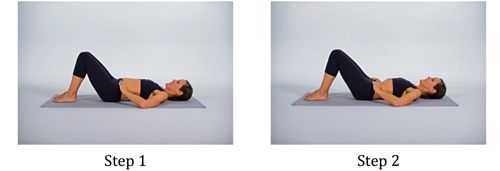By Jennifer Kitchens, author of the Dirty Dishwater, Holy Hands blog
Some photos in this article provided by Lindsay Brin. Used by permission.
“Most insurance companies will cover a tummy tuck to repair it. Don’t worry.”
“Wait. What? Surgery? What is this again? I don’t want to have surgery!”
This was my introduction to diastasis recti, also called “mommy tummy”. As I was finishing a regular prenatal visit, I awkwardly sat up on the examining table and commented, “It looks like I have a football under my shirt!” The doctor interrupted me, and asked me to lean up again, as if doing a crunch. She felt my abdomen and told me the football shape was created by a gap between my abdominal muscles.
These muscles (the recti muscles, which are associated with six-pack abs) separate (create a diastasis) at the midline due to weak transverse abdominal muscles (the ones that wrap around the body like a girdle) or connective tissue. That was when she told me not to worry. Telling a pregnant woman not to worry doesn’t accomplish much.
God designs women’s bodies to adapt to the growing life inside then adapt after the baby is born.
I was a bit panicked as I headed home. I’ll confess, I never stopped to pray and declare my trust in the One who knows my body best, the One knitting this baby together inside my womb (link to Psalm 139:14). Then I did what you shouldn’t do: I researched the condition and the surgery to repair it on the internet. I learned that my growing pregnant belly would only cause the separation to grow and the muscles would be limited in how much they closed the gap after delivery. My research indicated I would need major surgery that would limit or prevent me from holding our new baby.
I didn’t accept this. I began researching non-surgical options and applied what I learned. I realized God designed women’s bodies to adapt to a growing life then adapt after the baby was born. A few weeks later, I asked my doctor to recheck my diastasis, which is usually measured by finger widths. When I was diagnosed, I was four months pregnant, and the separation was already five fingers wide. When she rechecked me, it had reversed to three finger widths.
Maybe you carried a baby several years ago and you work out but your tummy isn’t flattening. Perhaps you have a pooch that makes you look pregnant when you aren’t. I can’t guarantee that a diastasis recti is causing your belly bulge, but it’s worth considering – and the exercises used to repair it won’t hurt you but will only make you stronger.
COULD I HAVE A DIASTASIS RECTI?
Both women and men can experience a diastasis recti caused by sudden weight gain (like pregnancy), abdominal surgery, poor abdominal muscle tone, or a combination of these factors. Due to increased abdominal pressure during pregnancy, however, women are at high risk. According to Lindsay Brin, C.P.T. & B.S.E. Exercise Science and prenatal/postnatal expert, “diastasis recti occurs in 33-60% of pregnant women” and “in a study done with 300 women, about 45% of these moms had a mild case at 6 months postpartum.” Unless a diastasis is repaired, it will get worse with each subsequent pregnancy. Since many people with a diastasis live normal lives, often, they never know they have it.
The aesthetic concern is a muffin top or bulge.
More significant, however, are the potential medical side effects.
I just happened to be pregnant when my diastasis was diagnosed, but that’s not always the case. Lindsay Brin’s organization, Moms into Fitness, offers a video that walks you through a general self-test. It involves laying on a flat surface and doing a small crunch to activate core muscles, putting internal pressure on the abdomen. While holding the crunch, feel along your midline. A space above or below your belly button where your fingers sink down may signify a diastasis. It is normal to have gap of one to two finger widths (up to 2.7 cm), but if the gap is more than 2 finger widths, it is considered a diastasis. If you detect a diastasis, please seek the counsel of a medical professional.
POSSIBLE COMPLICATIONS
You’ve just checked your own abdomen; now you are wondering what could happen because of this condition. Remember that many people don’t realize they have this condition and lead healthy, normal lives. However, there are two concerns to having a diastasis: aesthetic and medical.
The aesthetic concern is a muffin top or bulge. When you are working out, and your tummy is not flattening, or when you feel like you still look pregnant and your youngest is four years old your self-esteem takes a hit. More significant, however, are the potential medical side effects. According to Julie Tupler, RN and creator of the Tupler Technique for healing a diastasis recti, “Back pain, poor posture, pelvic floor problems, gastro- intestinal disturbances like constipation and bloating are all symptoms that occur when the support system for the back and organs is the weak connective tissue instead of the muscles.” She also suggests that a diastasis may lessen the effectiveness of pushing in labor.
More pregnancy related content from Faith & Fitness Magazine:
EXERCISES TO REPAIR
Moms into Fitness was key in equipping me heal my diastasis without surgery. Here is what I found through research and personal experience:
When you are pregnant:
–First and most importantly, seek the counsel of your medical care provider!
Here are some options to consider:
-Wear a maternity support or splint to help your abdominal muscles support the weight of the baby and the intra-abdominal pressure.
-Sit straight and tall and take a deep breath, expanding the belly. Exhale through the mouth drawing in the belly button as if bringing it to your spine. This creates an awareness of the muscles that are supposed to be working.
-To get up from a lying position, roll to your side and use hands to push up rather than engaging the abdominal muscles to sit straight up.
-Wait until after the baby is born to retrain muscles.
-Remember this is not about cutting calories. Dieting will not correct a diastasis recti and could hinder your baby’s development.

When you are not pregnant:
Don’t begin these exercises if you haven’t been cleared by your doctor after your last pregnancy. Please remember that the goal of these exercises is to use the transverse (horizontal) and oblique (diagonal) abdominals to bring the rectus (vertical) abdominal muscles together and heal the connective tissue.
-Lay flat on your back and take a deep breath, allowing your belly to expand while keeping the shoulders still. Hold it and then blow out, concentrating on pushing the breath out by pulling your bellybutton to your spine. This increases awareness of muscles to be targeted and initiates the training process.
-Lay on your back with your knees bent and your pelvis tilted so that your lower back is flat on the ground. Place a hand under the small of your back and your other hand on your tummy to make sure your abs stay flat, and your pelvis is tucked in. Slide one foot at a time out and back in, keeping the abs engaged and flat. Work toward 10 repetitions on each side. To add challenge, extend your alternating arm above your head with each leg extension.
-Perform assisted crunches using a towel under your back and crossed in front of you. Pull the ends of the towel when you lift just your head and shoulders off the floor. The towel helps keep your abs flat as you lift.
-Perform these every other day. If you find yourself using glute muscles to complete these exercises, put your feet on a couch or spread your knees like a butterfly’s wings to keep them from being used.

Be careful with these activities and exercises which can cause further separation:
-The sit ups and crunches most of us learned in gym class
-Planks without the pelvis and core engaged
-Lifting heavy items (even baby carriers or children) without the core engaged
Lindsay Brin has a great video, Core Firing Sequence, that shows these exercises and more, divided into three progressing phases. Each segment ranges from seven to ten minutes, targeting the core without a huge time commitment. This video was a huge part of my journey.
I visited my OB/GYN several months ago and asked her to check the diastasis. It’s completely healed. She said she could feel the ridge where my abdominal muscles meet at the midline. This didn’t happen overnight. It took many months of work and awareness of how I was using my abdominal muscles.
Exercise, trust God and get to know Him more closely as you find healing and strength.
I continue to be amazed in new ways by how God designed the human body to stretch and be used as He creates life and how He also made it to recover afterward. Your Creator loves you and knows you intimately- every cell of you. You might be surprised, as I was, by what God made your body capable of. The time I spent doing these exercises was time I had to force myself to slow down. As my body got used to the exercises, my mind was able to shift focus to what God was revealing to me through His Word and on praying. Please trust Him during this process and get to know Him in a new way while healing from a diastasis recti.
This article first appeared in the Women’s Interest department of the August/September 2017 issue of Faith & Fitness Magazine.







